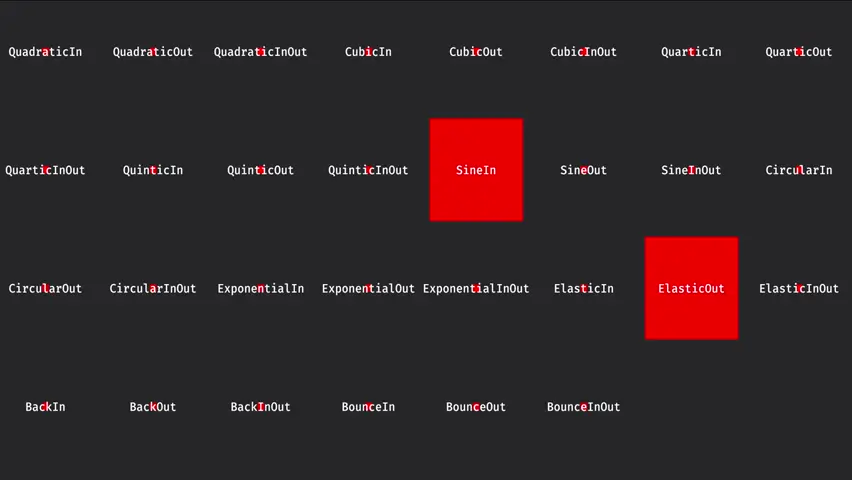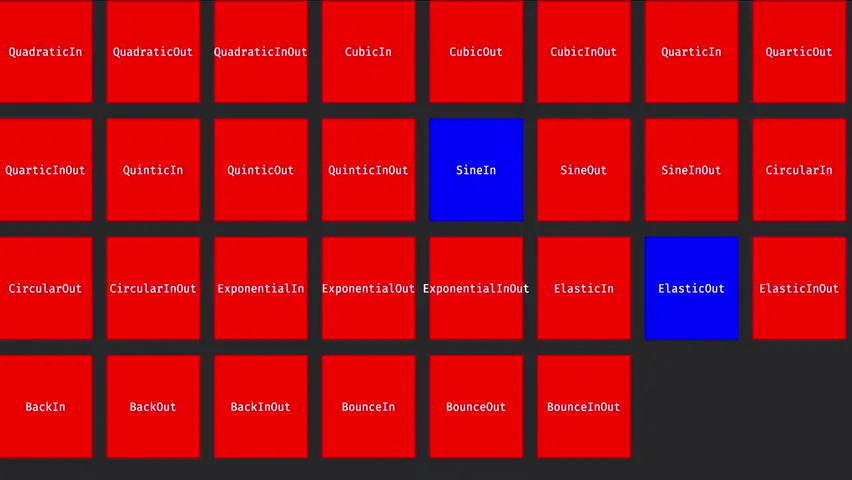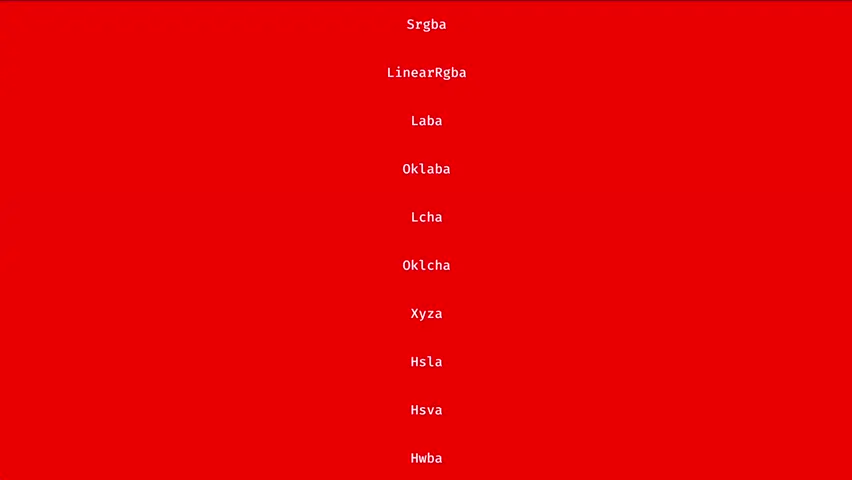Easings on Bevy components using interpolation.
Add the plugin to your app:
use bevy::prelude::*;
use bevy_easings::EasingsPlugin;
fn main() {
App::new()
.add_plugins(EasingsPlugin::default());
}And then just ease your components to their new state!
use bevy::prelude::*;
use bevy_easings::Ease;
fn my_system(mut commands: Commands){
commands
.spawn((
Sprite {
..Default::default()
},
Sprite {
custom_size: Some(Vec2::new(10., 10.)),
..Default::default()
}
.ease_to(
Sprite {
custom_size: Some(Vec2::new(100., 100.)),
..Default::default()
},
bevy_easings::EaseFunction::QuadraticIn,
bevy_easings::EasingType::PingPong {
duration: std::time::Duration::from_secs(1),
pause: Some(std::time::Duration::from_millis(500)),
},
),
));
}If the component being eased is not already a component of the entity, the component should first be inserted for the target entity.
You can also ease to a target that is generated dynamically from the previous value using a function:
use bevy::prelude::*;
use bevy_easings::Ease;
fn my_system(mut commands: Commands){
commands
.spawn((
Transform::from_scale(Vec3::new(0.1, 0.1, 1.0))
.ease_to_fn(
|start| Transform {
scale: start.scale * 10.0,
..*start
},
bevy_easings::EaseFunction::QuadraticIn,
bevy_easings::EasingType::PingPong {
duration: std::time::Duration::from_secs(1),
pause: Some(std::time::Duration::from_millis(500)),
},
)
.ease_to_fn(
|prev| Transform {
scale: prev.scale * 0.5,
..*prev
},
bevy_easings::EaseFunction::CubicInOut,
bevy_easings::EasingType::Once {
duration: std::time::Duration::from_secs(2),
},
).with_original_value(),
));
}This is particularly useful to rescue you from repeatly writing initialize code for start status, or chaining animation without worrying about maintaining interior status.
The EaseMethod enum can be used to provide easing methods that are not avaliable in EaseFunction.
pub enum EaseMethod {
/// Follow `EaseFunction`
EaseFunction(EaseFunction),
/// Linear interpolation, with no function
Linear,
/// Discrete interpolation, eased value will jump from start to end
Discrete,
/// Use a custom function to interpolate the value
CustomFunction(fn(f32) -> f32),
}This is shown below
use bevy::prelude::*;
use bevy_easings::Ease;
fn my_system(mut commands: Commands){
commands
.spawn((
Sprite {
..Default::default()
},
Sprite {
custom_size: Some(Vec2::new(10., 10.)),
..Default::default()
}
.ease_to(
Sprite {
custom_size: Some(Vec2::new(100., 100.)),
..Default::default()
},
bevy_easings::EaseMethod::Linear,
bevy_easings::EasingType::PingPong {
duration: std::time::Duration::from_secs(1),
pause: Some(std::time::Duration::from_millis(500)),
},
),
));
}You can chain easings, if they are not set to repeat they will happen in sequence.
use bevy::prelude::*;
use bevy_easings::Ease;
fn my_system(mut commands: Commands){
commands
.spawn((
Sprite {
..Default::default()
},
Sprite {
custom_size: Some(Vec2::new(10., 10.)),
..Default::default()
}
.ease_to(
Sprite {
custom_size: Some(Vec2::new(300., 300.)),
..Default::default()
},
bevy_easings::EaseFunction::QuadraticIn,
bevy_easings::EasingType::Once {
duration: std::time::Duration::from_secs(1),
},
)
.ease_to(
Sprite {
custom_size: Some(Vec2::new(350., 350.)),
..Default::default()
},
bevy_easings::EaseFunction::QuadraticIn,
bevy_easings::EasingType::PingPong {
duration: std::time::Duration::from_millis(500),
pause: Some(std::time::Duration::from_millis(200)),
},
),
));
}To be able to ease a component, it needs to implement the traits Default and Lerp. This trait is re-exported by beavy_easings.
use bevy::prelude::*;
use bevy_easings::*;
#[derive(Default, Component)]
struct CustomComponent(f32);
impl Lerp for CustomComponent {
type Scalar = f32;
fn lerp(&self, other: &Self, scalar: &Self::Scalar) -> Self {
CustomComponent(interpolation::lerp(&self.0, &other.0, scalar))
}
}The basic formula for lerp (linear interpolation) is self + (other - self) * scalar.
Then, the system custom_ease_system::<CustomComponent> needs to be added to the application.
See examples
When easing colors, pay attention on the color space you are using
Many ease functions are available:
- QuadraticIn
- QuadraticOut
- QuadraticInOut
- CubicIn
- CubicOut
- CubicInOut
- QuarticIn
- QuarticOut
- QuarticInOut
- QuinticIn
- QuinticOut
- QuinticInOut
- SineIn
- SineOut
- SineInOut
- CircularIn
- CircularOut
- CircularInOut
- ExponentialIn
- ExponentialOut
- ExponentialInOut
- ElasticIn
- ElasticOut
- ElasticInOut
- BackIn
- BackOut
- BackInOut
- BounceIn
- BounceOut
- BounceInOut
| Bevy | bevy_easings |
|---|---|
| main | main |
| 0.15 | 0.15 |
| 0.14 | 0.14 |
| 0.13 | 0.14 |
| 0.12 | 0.12 |
| 0.11 | 0.11 |
| 0.10 | 0.10 |
| 0.9 | 0.9 |
| 0.8 | 0.8 |
| 0.7 | 0.7 |
| 0.6 | 0.6 |
| 0.5 | 0.4 |





